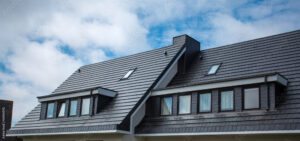Roofing is covering and protecting a house or building from rain, snow, sunlight, and temperature extremes. It can be made of many materials, from simple shingles to elaborate stone archways.

Metal roofs are durable and attractive, adding value to homes. They can withstand strong winds, and many manufacturers offer lifetime, non-prorated warranties.
Sheet metal is a durable, eye-catching alternative to traditional roofing styles that sets your house apart. Unlike asphalt shingles, which are individually constructed and can be affected by different weather conditions, metal roofs are made from a single sheet of metal customized to your home’s exact size and shape. Sheet metal is available in various colors and finishes to suit your style.
A metal roof is also more energy efficient than a typical roof. Because light-colored sheets reflect the sun instead of absorbing it, they help lower your electricity bills in the summer, while the thickness and insulation of the roof help reduce heating costs in the winter. Additionally, many steel panels used in a metal roof are made from recycled material (up to 56%), making it a very environmentally friendly choice for homeowners.
A metal roof begins with a metal coil or sheet that’s treated and coated to resist corrosion. From there, it’s rolled out and processed into the panel that will make up your roof. It can include slitting, cutting to length, tapering, or other techniques that create the final product.
There are three main types of metal panel roofing:
Corrugated metal is a metal sheet strengthened by forcing alternating grooves and ridges into it. It makes it very durable and increases its strength-to-weight ratio. It is the most common type of metal roof panel, as it can fit into any home style and is quick to install.
It’s also easy to customize, with various color and finish options. The groove also creates a pleasing aesthetic and hides small imperfections from the elements that would otherwise be exposed. Corrugated metal is a great option for homeowners, builders, or architects who want to cut installation costs by avoiding the additional expense of covering the entire roof with sheathing and insulation.
Another popular metal roof is the standing seam. These panels run vertically from eave to ridge and connect using a concealed fastener system. These panels are a good choice for commercial projects because they attach directly to the structural framing, providing the diaphragm, sheathing, and waterproofing in one.
The shingles on your roof provide protection, style, and visual appeal to your home. Although most homeowners give little thought to the material their shingles are made of when it’s time to replace them, there are several options to consider when choosing the right type for your home.
Asphalt shingles are the most popular choice for a new roof or a replacement. They comprise a base mat, a layer of waterproof asphalt, and granules on top that offer color and contrast to the ceiling. The granules also help to repel water and keep the shingle from getting too wet. The granules are available in various colors to fit your look and vision for your home.
In recent years, shingle manufacturing innovations have increased asphalt shingles’ performance. It means they are more resistant to high winds and can still hold up in tropical storms and hurricanes. Many manufacturers also offer class 4 impact resistance ratings for their shingles, which can reduce your insurance premium if available in your area.
One downside to asphalt shingles is that they tend to get wet easily and can be susceptible to mold, mildew, and other problems. To help protect against this, you’ll want to ensure your roof is properly ventilated and installed to the manufacturer’s specifications. Most shingle warranties will only cover the cost of replacing your shingles if damaged by an act of nature or improper installation.
Other shingle options include wood shingles, which have a rich history that dates back centuries. These shingles are durable and fire-resistant and come in various tones that can be mixed to create a more unique and interesting appearance. They are more expensive than other shingle types but may last up to 50 years or more.
Other options for a new shingle roof include laminate and architectural shingles. These shingles are thicker and heavier than three-tab shingles and offer more options in terms of aesthetics and durability. They’re a good option for homeowners who want to upgrade the appearance of their shingle roof without spending a fortune.
As one of the layers that make up your roof system, the underlayment creates a secondary barrier between the roof deck and the roofing material. It helps prevent water and wind from infiltrating the house through the roof and minimize moisture damage in vulnerable areas. Underlayment is typically made of asphalt-saturated felt or modern synthetic materials and can come in various thicknesses. The type of underlayment that’s best for your home depends on several factors, including roof type and climate.
Felt underlayment, tar paper, or asphalt-soaked felt is the most common underlayment material for wood and tile roofing. It’s available in lightweight (15-pound) and heavy-duty (30-pound) varieties, which provide good protection for most homes. Felt is easily installed on most low-slope roofs, as it requires only basic tools and can be stapled to the underside of the roof sheathing. Felt is also popular for metal roofing because it doesn’t expand as much as other roof materials. However, it does not hold up well in high-temperature environments and doesn’t offer the same level of water resistance as other underlayment materials.
Rubberized underlayment is an excellent choice for metal and shingle roofs, as it’s highly adhesive and waterproof. It’s a great option for colder climates because it performs well in frigid temperatures and prevents leaks from ice dams. It’s also easy to install and provides a great moisture barrier over the roof deck, allowing humidity to escape.
Synthetic underlayment is quickly gaining popularity as it’s easy to install and durable. These lightweight sheets are typically woven from polypropylene or polyethylene and often include shingle or nailing patterns printed on them to guide installers during installation. They’re also waterproof, allow humidity to escape, and offer good resistance against rot.
Some synthetic underlayments are designed to be self-adhering and can be used as a replacement for traditional felt underlayments. These peel-and-stick products have a rubberized asphalt or butyl-based adhesive mounted on a polyethylene carrier sheet. They can be used on low-slope roofs if they’re overlapped by about 50%.
The most common flashing is made of metal. It can be manufactured from copper, aluminum, or galvanized steel. Copper is the most durable and attractive option for flashing, as it doesn’t develop rust and looks good with various roof coverings. It is also less expensive than other options, although it can still be pricey.
Flashing prevents infiltration by directing water, penetrating damp, and debris build-up away from vulnerable areas. It’s used on surfaces susceptible to moisture, like wall cladding and gutters, as well as around window frames, doors, chimneys, and other roof protrusions. It can be installed like shingles, with each piece overlapping another, or sealed to function as one continuous surface.
A skilled roofer can install many different types of flashing. Some are fabricated from a single strip of metal, which can be effective in some situations, such as where dormers or other protrusions meet the roof’s surface. However, a continuous strip can be difficult to work with because it’s not flexible enough to flex with changes in exterior temperatures.
Other flashing is fabricated from a series of pieces overlapping in a “step” pattern. This type of flashing is commonly used at the low points where two roof slopes meet, called valleys. It can be hidden under shingles or left exposed, and it may have an integrated drip edge for extra protection from rainwater.
Other types of flashing include cap flashing, which covers the top of a wall flashing, or ridge flashing and can be used to add decorative features to the roof’s surface. Sill flashing is concealed beneath windows and doors to prevent water from entering walls, and kick-out flashing deflects moisture that has penetrated the wall cladding. It can be installed in a wall or a roof, and it may span the thickness of a barrier to direct water to weep holes.



